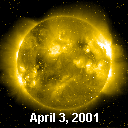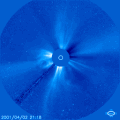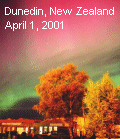|   SPACE WEATHER SPACE WEATHER
Current
Conditions
Solar Wind
velocity: 457.0 km/s
density:3.9 protons/cm3
explanation | more data
Updated: Today at 2246 UT
NOTE: ACE solar wind data (reported above) might be unreliable during the ongoing solar radiation storm. Check the SOHO Proton Monitor instead.
X-ray Solar Flares
6-hr max: C8 1740 UT Apr03
24-hr: X20 2155 UT Apr02
explanation | more data
Updated: Today at 2250 UT
Daily Sun: 03 Apr '01 
As evidenced by Monday's record-breaking flare, the large sunspot group 9393 is still a threat for powerful explosions as it rotates over the Sun's western limb. A new sunspot, itself the source of at least one X-class flare on Monday, is emerging over the southeast limb.
Sunspot Number: 223
More about sunspots
Updated: 02 Apr 2001
Radio Meteor Rate
24 hr max: 39 per hr
Listen to the Meteor Radar!
Updated: 02 Apr 2001 Interplanetary Mag. Field
Btotal: 7.4 nT
Bz: 2.8 nT south
explanation | more data
Updated: Today at 2248 UT Coronal Holes:

There are no substantial coronal holes in this ultraviolet image of the Sun. The many speckles are energetic solar particles striking the camera -- the result of an ongoing radiation storm around Earth. Image credit: SOHO Extreme UV Telescope.
More about coronal holes
 SPACE WEATHER SPACE WEATHER
NOAA
Forecasts
Solar Flares: Probabilities for a medium-sized (M-class) or a major (X-class) solar flare during the next 24/48 hours are tabulated below.
Updated at 2001 Apr 03 2200 UT
| FLARE | 24 hr | 48 hr | | CLASS M | 85 % | 80 % | | CLASS X | 35 % | 30 % |
Geomagnetic Storms: Probabilities for significant disturbances in Earth's magnetic field are given for three activity levels: active, minor storm, severe storm
Updated at 2001 Apr 03 2200 UT Mid-latitudes | 24 hr | 48 hr | | ACTIVE | 35 % | 35 % | | MINOR | 30 % | 30 % | | SEVERE | 25 % | 15 % |
High latitudes | 24 hr | 48 hr | | ACTIVE | 25 % | 25 % | | MINOR | 35 % | 35 % | | SEVERE | 35 % | 30 % |

Web server provided by
VPS Hosting
| What's Up in Space -- 3 Apr 2001
Subscribe to Space Weather News! BIG FLARE: The most powerful solar flare ever recorded -- an X20-class event -- erupted near sunspot 9393 at 2150 UT on April 2nd. The event was even stronger than a well-known flare in March 1989 that led to the collapse of a power grid in Quebec. No such calamities are likely this time, however, because sunspot 9393 -the source of the explosion- is near the Sun's west limb; the bulk of the explosion was directed away from Earth. (Note: Monday's flare was initially classified as X17, but it was since been upgraded to X20.)  The flux of 10 MeV solar protons surrounding our planet has soared to approximately 10,000 times normal. Such radiation levels pose no appreciable hazard to air travelers, astronauts or satellites. The ongoing radiation storm is a NOAA S2- to S3-category event.  Right: Monday's explosion hurled a coronal mass ejection into space. The expanding cloud raced away from the Sun's western limb -- and mostly away from Earth. The many speckles peppering this SOHO coronagraph image are energetic solar particles striking the instrument's CCD camera. Right: Monday's explosion hurled a coronal mass ejection into space. The expanding cloud raced away from the Sun's western limb -- and mostly away from Earth. The many speckles peppering this SOHO coronagraph image are energetic solar particles striking the instrument's CCD camera.
SUNSPOT 9393: AR9393 --the largest sunspot since 1991-- will very soon disappear over the Sun's western limb. The behemoth spot is still a whopper covering an area of the solar disk equivalent to about ten planet Earths. There's still time to see this huge spot for yourself, but be careful: Looking directly at the Sun can cause permanent eye damage. Click to learn more about safe solar observing.  AURORAL WEEKEND: A powerful geomagnetic storm raged for more than 24 hours this weekend, dazzling sky watchers who saw aurora borealis as far south as Mexico. The storm began at 0100 UT on March 31st (8 p.m. EST on March 30th) when a coronal mass ejection (CME) struck Earth's magnetosphere. The leading edge of the CME was dense (150 protons/cm3) and strongly magnetized -- traits that can (and did) give rise to intense auroras. Veteran aurora watchers describe the display as arguably the most photogenic of the current solar cycle. AURORAL WEEKEND: A powerful geomagnetic storm raged for more than 24 hours this weekend, dazzling sky watchers who saw aurora borealis as far south as Mexico. The storm began at 0100 UT on March 31st (8 p.m. EST on March 30th) when a coronal mass ejection (CME) struck Earth's magnetosphere. The leading edge of the CME was dense (150 protons/cm3) and strongly magnetized -- traits that can (and did) give rise to intense auroras. Veteran aurora watchers describe the display as arguably the most photogenic of the current solar cycle.
See the Weekend Aurora Gallery The CME that hit Earth's magnetosphere on March 31st was blasted into space by explosions near the giant sunspot 9393. WEB LINKS: NOAA FORECAST | GLOSSARY | SPACE WEATHER TUTORIAL | LESSON PLANS | BECOME A SUBSCRIBER | 
Potentially Hazardous Asteroids (PHAs) are space rocks larger than approximately 100m that can come closer to Earth than 0.05 AU. None of the known PHAs are on a collision course with our planet, although astronomers are finding new ones all the time. [more]
On 3 Apr 2001 there were 298 known Potentially
Hazardous Asteroids ASTEROIDS GALORE: March has been a good month for asteroid hunters. Since March 21st astronomers have spotted six Earth-approaching space rocks (click to view 3D orbits): 2001 FE90, 2001 FB90, 2001 FD58, 2001 FC58, 2001 FA58 and 2001 FO32. There is no danger of a collision with any of these asteroids. Earth-asteroid encounters (Mar 1 - Apr 30) 
- TOTAL LUNAR ECLIPSE: On Jan. 9, 2001, the full Moon glided through Earth's copper-colored shadow. [gallery]
- CHRISTMAS ECLIPSE: Sky watchers across North America enjoyed a partial solar eclipse on Christmas Day 2000 [gallery]
- LEONIDS 2000: Observers around the globe enjoyed three predicted episodes of shooting stars. [gallery]
 Feb. 21, 2001: Nature's Tiniest Space Junk -- Using an experimental radar at the Marshall Space Flight Center, scientists are monitoring tiny but hazardous meteoroids that swarm around our planet. Feb. 15, 2001: The Sun Does a Flip -- NASA scientists who monitor the Sun say our star's enormous magnetic field is reversing -- a sure sign that solar maximum is here. Jan. 25, 2001: Earth's Invisible Magnetic Tail -- NASA's IMAGE spacecraft, the first to enjoy a global view of the magnetosphere, spotted a curious plasma tail pointing from Earth toward the Sun. Jan. 4, 2001: Earth at Perihelion -- On January 4, 2001, our planet made its annual closest approach to the Sun. Dec. 29, 2000: Millennium Meteors -- North Americans will have a front-row seat for a brief but powerful meteor shower on January 3, 2001. Dec. 28, 2000: Galileo Looks for Auroras on Ganymede -- NASA's durable Galileo spacecraft flew above the solar system's largest moon this morning in search of extraterrestrial "Northern Lights" Dec. 22, 2000: Watching the Angry Sun -- Solar physicists are enjoying their best-ever look at a Solar Maximum thanks to NOAA and NASA satellites. MORE SPACE WEATHER HEADLINES |

